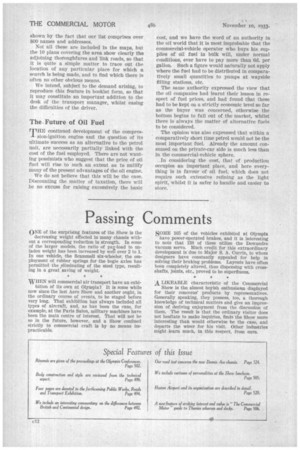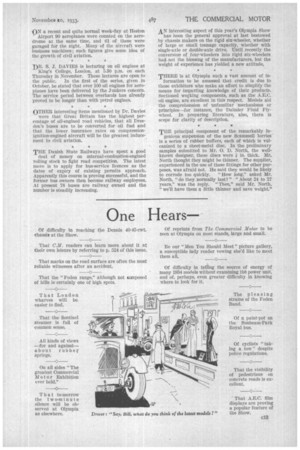Passing Comments
Page 42

Page 43

If you've noticed an error in this article please click here to report it so we can fix it.
ONE of the surprising features of the Show is the decreasing weight effected in many chassis without a corresponding reduction in strength. In some of the larger models, the ratio of pax-load to unladen weight has been increased by well over 2 to 1. In one vehicle, the Scammell six-wheeler, the employment of rubber springs for the bogie axles has permitted the ,eliminating of the steel type, resulting in a great saving of weight.
WHEN will commercial air transport have an exhi
bition of its own at Olympia? It is some while now since the last Aero Show and another ought, in the ordinary course of events, to be staged before very long. That exhibition has always included all types of aircraft, and, as has been the case, for example, at the Paris Salon, military machines have been the main centre of interest. That will not be so in the future, however, and a Show confined strictly to commercial craft is by no means impracticable. SOME 165 of the vehicles exhibited at Olympia
have power-operated brakes, and it is interesting to note that 138 of these utilize the Dewandre vacuum servo. Much credit for this extraordinary development is due to Major S. A. Currin, to whom designers have constantly appealed for help in solving their braking problems. Layouts have often been completely altered, thus dispensing with crossshafts, joints, etc., proved to be superfluous.
A. LIKEABLE characteristic of the Commercial
Show is the almost boyish enthusiasm displayed for their concerns' products by representatives. Generally speaking, they possess, too, a thorough knowledge of technical matters and give an impression of deriving enjoyment from the discussion of them. The result is that the ordinary visitor does not hesitate to make inquiries, finds the Show more interesting than would otherwise be the case, and departs the wiser for his visit. Other industries might -learn much, in this respect, from ours.
ON a recent and quite normal week-day at Heston
Airport 90 aeroplanes were counted on the aerodrome at the same time, and 61 of these were garaged for the night. Many of the aircraft were business machines ; such figures give some idea of the growth of civil aviation.
DR. S. J. DAVIES is lecturing on oil engines at King's College, London, at 5.30 p.m. on each Thursday in November. These lectures are open to
the public. In the first of the series, given in October, he stated that over 100 oil engines for aeroplanes have been delivered by the Junkers concern. The service period between overhauls has already proved to be longer than with petrol engines.
OTHER interesting items mentioned by Dr. Davies were that Great Britain has the highest percentage of oil-engined road vehicles, that all Dresden's buses are to be converted for oil fuel and that the lower insinance rates on compressionignition-engined aircraft will be the greatest inducement to civil aviation.
THE Danish State Railways have spent a good deal of money on internal-combustion-engined rolling stock to fight road competition. The latest move is to apply for bus-service licences as the dates of expiry of existing permits approach. Apparently this course is proving successful, and the former bus owners then become railway employees. At present 78 buses are railway owned and the number is steadily increasing.
AN interesting aspect of this year's Olympia Show has been the general approval at last bestowed by chassis makers on the rigid six-wheeler, whether of large or small tonnage capacity, whether with single-axle or double-axle drive. Until recently the conversion of four-wheelers into rigid six-wheelers had not the blessing of the manufacturers, but the weight of experience has yielded a new attitude,
THERE is at Olympia such a vast amount of information to be amassed that credit is due to • those exhibitors who make an effort to simplify the means for imparting knowledge of their products. Sectioned working components, such as the A.E.C. oil engine, are excellent in this respect. Models aid the comprehension of unfamiliar mechanisms or principles—for instance, the Daimler Fluid Flywheel. In preparing literature, also, there is scope for clarity of description.
THE principal component of the remarkably in genious suspension of the new Scammell lorries is a series of rubber buffers, each of which is vulcanized to a sheet-metal disc. In the preliminary samples submitted to Mr. 0. D. North, the wellknown designer, these discs were in. thick. Mr. North thought they might be thinner. The supplier, experienced in the use of these fittings for other purposes, was afraid not. He said they would be likely to corrode too quickly. "How long," asked Mr. North, "do they normally last?" "About 24 to 27 years," was the reply. 'Then," said Mr. North, "we'll have them a little thinner and save weight."




























































































































